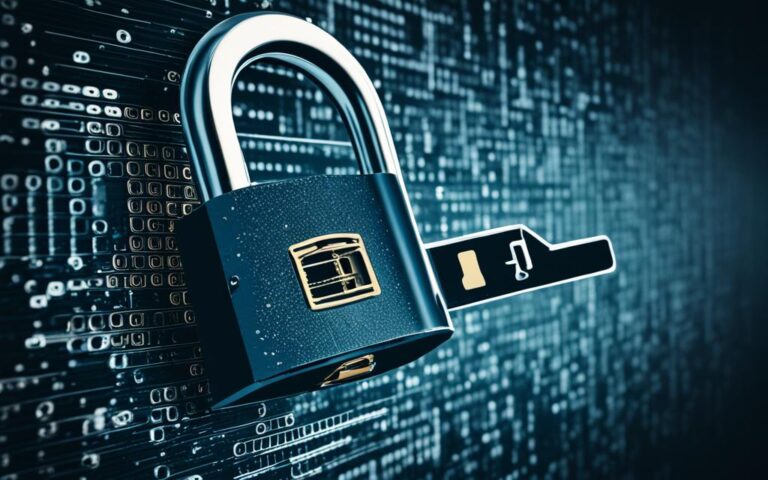The Role of Physical Destruction in Data Security Strategies
In the era of growing digital threats, businesses need robust data security strategies to protect their sensitive information. One crucial aspect of these strategies is hard drive destruction. By incorporating physical destruction methods into their data security protocols, businesses can ensure the permanent disposal of digital data, safeguarding it from unauthorized access and potential data breaches.
Physical destruction involves the complete destruction of storage media, such as hard drives, CDs, or tapes, making the data on these devices impossible to retrieve. This method provides businesses with an effective and secure solution to permanently dispose of sensitive information.
Not only does physical destruction contribute to the overall data security strategy, but it also helps businesses to comply with data protection regulations. By securely destroying and disposing of confidential and sensitive information, companies can demonstrate their commitment to compliance assurance.
Furthermore, physical destruction plays a crucial role in preventing data breaches. Securely destroying confidential documents and electronic media ensures that sensitive information remains inaccessible to unauthorized individuals, mitigating the risk of data breaches and potential reputational damage.
Implementing physical destruction methods in data security strategies also allows businesses to practice environmental responsibility. By securely shredding and recycling materials, companies can reduce their carbon footprint and contribute to a sustainable future.
In addition to enhancing data security and protecting sensitive information, physical destruction helps businesses optimize operational costs. By reducing storage expenses associated with outdated or redundant media and ensuring efficient use of resources and employees, businesses can streamline their operations and focus on growth.
Overall, the role of physical destruction in data security strategies is paramount. Incorporating this method ensures the permanent disposal of sensitive information, compliance with data protection regulations, prevention of data breaches, environmental sustainability, and improved operational efficiency.
What is Data Destruction and Why is it Important?
Data destruction, or data shredding, is the process of permanently destroying data from digital storage devices. It is crucial for safeguarding sensitive information in an age where data security is paramount.
Proper data destruction plays a crucial role in protecting businesses and individuals from data breaches and unauthorized access. By securely disposing of confidential information, data destruction ensures that sensitive data remains inaccessible to malicious entities.
Moreover, data destruction is necessary to maintain compliance with data protection regulations. In today’s digital landscape, businesses are entrusted with vast amounts of personal and sensitive data. It is their responsibility to handle and dispose of this data securely and responsibly.
“Data protection is about safeguarding privacy and ensuring compliance assurance.”
By implementing effective data destruction practices, businesses can promote compliance assurance and demonstrate their commitment to protecting sensitive information. This is especially significant in industries such as healthcare, finance, and technology, where data privacy is of utmost importance.
In addition to safeguarding sensitive information and maintaining compliance, data destruction also has cost and environmental benefits. By securely disposing of outdated or unnecessary data, businesses can optimize operational costs by reducing storage expenses. Furthermore, proper disposal and recycling of electronic media contribute to environmental responsibility and sustainability.
Benefits of Data Destruction:
- Protects sensitive information
- Ensures compliance assurance
- Prevents data breaches
- Promotes environmental responsibility
- Optimizes operational costs
It is essential for businesses to prioritize data destruction as part of their data security strategies to mitigate risks, safeguard sensitive information, and maintain compliance with data protection regulations.
Common Methods of Data Destruction
When it comes to data destruction, there are several common methods that businesses can employ to ensure the permanent destruction of digital data. These methods include physical shredding, software overwriting, and degaussing.
Physical Shredding
Physical shredding involves the physical destruction of storage media such as hard drives or CDs. By shredding these devices, the data on them becomes impossible to retrieve. This method provides a high level of security and ensures that sensitive information remains protected.
Software Overwriting
Software overwriting is another common method of data destruction. It involves using specialized software to overwrite existing data with random patterns, making the original data unrecoverable. This method is effective in preventing data breaches and ensuring that confidential information remains secure.
Degaussing
Degaussing is a technique that is specific to magnetic media like tapes or floppy disks. It involves exposing these media to a strong magnetic field, effectively erasing all data stored on them. Degaussing ensures that sensitive information cannot be recovered, providing an added layer of security.
By employing these common methods of data destruction, businesses can safeguard their sensitive information and prevent unauthorized access. The use of physical shredding, software overwriting, and degaussing ensures that data is effectively and permanently destroyed, minimizing the risk of data breaches and providing peace of mind.
| Method | Description |
|---|---|
| Physical Shredding | Involves the physical destruction of storage media, rendering data impossible to retrieve. |
| Software Overwriting | Specialized software overwrites existing data with random patterns, ensuring the original data is unrecoverable. |
| Degaussing | Exposes magnetic media to a strong magnetic field, effectively erasing all data. |
Importance of Data Destruction for Businesses
Data destruction is an essential aspect of data security strategies for businesses in today’s digital landscape. The importance of data destruction cannot be overstated, as it helps protect sensitive information and ensures compliance assurance with data protection regulations. By securely disposing of financial records, personnel records, customer information, and medical records, businesses can safeguard valuable data from falling into the wrong hands.
Data destruction plays a crucial role in preventing data breaches and unauthorized access to confidential documents and electronic media. By securely destroying such sensitive information, businesses can mitigate the risk of costly data breaches and maintain the trust of their customers and stakeholders.
Furthermore, data destruction promotes environmental responsibility by securely shredding and recycling materials. This not only helps protect the environment but also allows businesses to demonstrate their commitment to sustainable practices.
Optimizing operational costs is another significant benefit of data destruction for businesses. By reducing storage expenses and efficiently utilizing resources and employees, businesses can streamline their operations and allocate valuable resources to more critical areas of their organization. This ultimately leads to improved efficiency and overall cost savings.
The Risks of Not Prioritizing Data Destruction
Failure to prioritize data destruction can have severe consequences for businesses. Not only do they risk potential data breaches, but they may also face legal repercussions for non-compliance with data protection regulations. Businesses that fail to securely destroy and dispose of confidential and sensitive information can face fines, legal action, and reputational damage.
The failure to prioritize data destruction can result in substantial financial losses, loss of customer trust, and damage to the business’s reputation.
Protecting Your Business with Compliance Assurance
Compliance assurance is vital for businesses to protect themselves from legal and financial liabilities. By implementing proper data destruction practices, businesses can ensure compliance with data protection regulations such as the GDPR (General Data Protection Regulation) in the United Kingdom.
The GDPR emphasizes the importance of secure data destruction and requires businesses to implement the necessary controls for protecting personal data. Secure data destruction methods, including physical shredding, software overwriting, degaussing, and erasure, help businesses meet these legal requirements and protect personal data from unauthorized access.
The Benefits of Data Destruction for Businesses
The benefits of data destruction for businesses are numerous and impactful:
- Protection of sensitive information
- Compliance assurance with data protection regulations
- Prevention of data breaches and unauthorized access
- Promotion of environmental responsibility
- Optimization of operational costs
By prioritizing data destruction, businesses can protect their sensitive information, comply with legal requirements, prevent data breaches, promote environmental sustainability, and streamline their operations.
Data Destruction Methods Comparison
| Method | Description | Advantages |
|---|---|---|
| Physical Shredding | Physically destroying storage media, rendering data unrecoverable | – Provides an effective and irreversible method of data destruction – Suitable for various storage devices |
| Software Overwriting | Overwriting existing data with random patterns, making the original data unrecoverable | – Allows for secure and efficient data destruction – Can be applied to a wide range of storage devices |
| Degaussing | Exposing magnetic media to a strong magnetic field to erase all data | – Provides a quick and reliable method of data destruction for magnetic storage media |
| Erasure | Removing digital pointers to data, making it difficult to retrieve | – Allows for quick data destruction – Can be applied to various digital storage devices |
Each data destruction method offers its advantages in terms of efficiency, effectiveness, and applicability to different storage devices. By selecting the most suitable method, businesses can ensure the secure and permanent destruction of their data.
Implementing a comprehensive data destruction strategy is crucial for businesses to protect sensitive information, comply with legal requirements, and minimize the risk of data breaches. By considering the importance of data destruction and adopting the appropriate methods, businesses can safeguard their valuable data and maintain a strong position in today’s data-driven world.
GDPR and Data Destruction
The GDPR (General Data Protection Regulation) sets out legal requirements for data protection and privacy in the European Union (EU). While it does not prescribe specific methods for data destruction, GDPR emphasizes the importance of secure data disposal to protect individuals’ personal information. Companies must comply with GDPR rules when destroying data to ensure the privacy and security of individuals’ data.
Compliance with GDPR
When destroying data, businesses need to implement the correct controls and procedures to comply with the GDPR. This includes giving data owners full rights over their data and ensuring that it is securely and permanently deleted. Failure to comply with GDPR requirements can result in significant fines and reputational damage. Several well-known companies have already faced hefty penalties for non-compliance.
Secure Data Destruction Methods
Secure data destruction methods are essential to meet GDPR requirements and protect individuals’ data. These methods include:
- Erasure: Erasing data by overwriting it with random patterns to make it unrecoverable.
- Overwriting: Overwriting existing data with new information to ensure the original data cannot be retrieved.
- Degaussing: Exposing magnetic media, such as tapes or floppy disks, to a strong magnetic field to erase all data.
- Physical Destruction: Shredding or crushing storage devices, such as hard drives, to render the data permanently inaccessible.
Implementing these secure data destruction methods helps businesses comply with GDPR regulations and safeguard individuals’ personal information from unauthorized access.
By following GDPR guidelines and utilizing secure data destruction methods, businesses can ensure the protection of personal data, maintain compliance with legal requirements, and safeguard their reputation.
Data Destruction Methods and Benefits
When it comes to secure data destruction, businesses have several methods at their disposal to ensure sensitive information is permanently destroyed. These methods include:
- Erasure or Formatting: This method removes digital pointers to the data, making it difficult to retrieve. However, it is important to note that erasure or formatting alone is not fully secure and can be vulnerable to advanced data recovery techniques.
- Overwriting: By changing the bits of the data, overwriting makes it more secure and less prone to recovery. Although it requires time and effort, it provides an added layer of protection.
- Degaussing: Degaussing utilizes a strong magnetic field to destroy the magnetic data on storage devices. This method renders the data completely unrecoverable. It is often used for magnetic media like tapes or floppy disks.
- Physical Destruction: Considered one of the most foolproof methods, physical destruction involves shredding or crushing the storage device. This ensures that the data is permanently destroyed and cannot be reconstructed.
Each data destruction method offers its own benefits for businesses:
- Legal Safeguarding: Proper data destruction helps businesses meet legal requirements, such as those outlined in the GDPR, by securely disposing of sensitive information and protecting against non-compliance penalties.
- Breach Protection: Destroying data through reliable methods safeguards businesses against data breaches, minimizing the risk of unauthorized access to confidential information.
- Business Streamlining: By securely destroying unnecessary data, businesses can streamline their operations, reducing storage costs and optimizing resource allocation.
- Customer Trust: Implementing robust data destruction methods demonstrates a commitment to protecting customer information, enhancing trust and confidence in the organization.
With a variety of data destruction methods available, businesses can choose the most suitable approach based on their specific needs and legal obligations. By prioritizing secure data destruction, businesses can enjoy the benefits of legal safeguarding, breach protection, streamlined operations, and strengthened customer trust.
Comparison of Data Destruction Methods
| Data Destruction Method | Security Level | Time/Effort Required | Media Compatibility |
|---|---|---|---|
| Erasure or Formatting | Lower | Low | Wide range |
| Overwriting | Higher | Moderate | Wide range |
| Degaussing | High | Low | Magnetic media |
| Physical Destruction | Highest | High | Various media |
Conclusion
Secure data destruction is of paramount importance for businesses to protect sensitive information, comply with data protection regulations, prevent data breaches, practice environmental responsibility, and optimize operational costs. By implementing methods such as physical shredding, software overwriting, and degaussing, businesses can ensure the permanent destruction of digital data.
Proper data destruction not only leads to legal safeguarding and breach protection but also enables streamlined business operations and strengthens customer trust. By securely disposing of financial records, personnel records, customer information, and medical records, businesses can safeguard sensitive information and maintain compliance with data protection regulations.
Furthermore, secure data destruction promotes environmental responsibility by securely shredding and recycling materials. This not only reduces the carbon footprint but also showcases a commitment to sustainability. Additionally, by optimizing operational costs through efficient use of resources and employees, businesses can allocate their budget in a more strategic way.
In today’s data-driven world, businesses cannot afford to overlook the importance of secure data destruction. It is crucial for businesses to prioritize data destruction in their data security strategies to protect confidential information, prevent data breaches, and build a strong reputation for trust and reliability among their customers.
FAQ
What is data destruction?
Data destruction is the process of permanently destroying data from digital storage devices to prevent unauthorized access and ensure that the data is unrecoverable.
Why is data destruction important?
Data destruction is important for several reasons. It helps safeguard sensitive information, comply with data protection regulations, prevent data breaches, practice environmental responsibility, and optimize operational costs.
What are the common methods of data destruction?
The common methods of data destruction include physical shredding, software overwriting, and degaussing. Physical shredding involves physically destroying storage media, software overwriting uses specialized software to overwrite data, and degaussing exposes magnetic media to a strong magnetic field to erase data.
Why is data destruction important for businesses?
Data destruction is important for businesses to protect sensitive information, ensure compliance with data protection regulations, prevent data breaches, and optimize operational costs.
How does GDPR relate to data destruction?
The GDPR emphasizes the importance of secure data destruction and requires companies to comply with its rules when destroying data. Secure data destruction methods include erasure, overwriting, degaussing, and physical destruction.
What are the benefits of data destruction?
The benefits of data destruction include legal safeguarding, breach protection, streamlined business operations, and strengthened customer trust.













